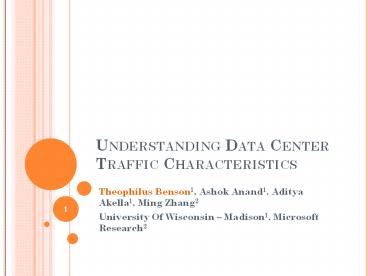Understanding Data Center Traffic Characteristics - PowerPoint PPT Presentation
Title:
Understanding Data Center Traffic Characteristics
Description:
UNDERSTANDING DATA CENTER TRAFFIC CHARACTERISTICS Theophilus Benson1, Ashok Anand1, Aditya Akella1, Ming Zhang2 University Of Wisconsin Madison1, Microsoft Research2 – PowerPoint PPT presentation
Number of Views:158
Avg rating:3.0/5.0
Title: Understanding Data Center Traffic Characteristics
1
Understanding Data Center Traffic Characteristics
- Theophilus Benson1, Ashok Anand1, Aditya Akella1,
Ming Zhang2 - University Of Wisconsin Madison1, Microsoft
Research2
2
Data Centers Background
- Built to optimize cost and performance
- Tiered Architecture
- 3 layers edge, aggregation, core
- Cheap devices at edges and expensive devices at
core - Over-subscription of links closer to the core
- Fewer links towards core reduce cost
- Trade negligible loss/delay for fewer devices and
links
3
Data Centers Today
Few large links
Expensive and scarce
Many little links
Cheap and abundant
Cisco Canonical DC Architecture
4
Challenges In Designing For Data Centers
- Very little is known about data centers
- No models for evaluation
- Lack of knowledge effects evaluation
- Use properties of wide area network traffic.
- Make up traffic matrixes/random traffic patterns.
- Insufficient for the following reasons
- Cant accurately compare techniques
- Oblivious to actual characteristics of data
centers
5
Data Center Traffic Characterization
- Goals of our project
- Understand low level characteristics of traffic
in data centers - What is the arrival process?
- Is it similar or distinct from wide area
networks? - How does low level traffic impact the data center?
6
Data Center Traffic Characterization
- In studying data center traffic we found that
- Few links experience loss
- Many links are unutilized
- Traffic adheres to ON-OFF
- Arrival process is log normal
7
Outline
- Background
- Goals
- Data set
- Observations and insights
- Overview of traffic generator (see paper for
details) - Conclusion
8
Data Sets
Type ofDC Mean Size( of Dev)
2-Tier 10 13
3-Tier 9 363
- Data from 19 data centers
- Differences in size and architecture
- Data for intranet and extranet server farms
- Applications messaging, search, video
streaming, email - Data consists of
- Packet traces from edge switches in one data
center - SNMP MIB of devices in all data centers
- Data collected over a span of 10 days
9
Analyzing Snmp Data
- Analyze link utilization and drops
- Analysis from one 5 minute interval
- Lot of un-utilized links
- Back-up/redundant links
- Aggregation layer has the most used links
- Funneling of traffic from aggregation
- Very few links with losses
Core Aggregation Edge
of links used 59 73 57
of links with at least one loss 4 3 2
10
Analyzing Snmp Data Link Utilization
- 95th percentile used
- Core gt Edge gt Aggregation
- Core has fewest links
- Edge has smaller, (1Gbps) links ? higher util.
than aggregation.
11
Analyzing Snmp Data Link Loss Rates
- Aggregation gt Edges gt Core
- Utilization Core gt Edges gt Aggregation
- Core has relatively little loss but high
utilization - All links loose less than 2 of packets
- Aggregation of flow leads to stability
- Edge Aggr have significantly higher losses
- Few links (20) experience high losses (over 40)
- Most likely due to bursty traffic
12
Insights From Snmp
- Loss is localized to a few links (4)
- Loss may be avoided by utilizing all links
- 40 of links are unused in some areas
- Reroute traffic
- Move applications/migrate virtual machine
- Inverse correlation between loss and utilization
- Should examine low level packet traces
- Traces from same 10 days as SNMP
13
Analyzing Packet Traces
- Time series of traffic on an edge link
- ON-OFF traffic at edges
- Time series shows ON-OFF patterns
- Binned in 15 and 100 m. secs
- ON-OFF persists
14
Analyzing Packet Traces
- What is the arrival process?
- Matlab curve-fitting (least mean square)
- Weibull, log normal, pareto, exponential
- Curve fits log-normal for the 3 distributions
- Inter-arrival, on-times, off-times
- All switches exhibit identical patterns
- Different from pareto (WAN) traffic
15
Data Center Traffic Generator
- Based on our insights we created a traffic
generator - Goal produce a stream of packets that exhibits
an ON-OFF arrival pattern - Input distribution of traffic volumes and loss
rates from SNMP pulls for a link - Output the parameters for a fine grained arrival
process that will produce the input distribution
16
Data Center Traffic Generator
- Approach
- Search the space of available parameters
- Simulate each set of parameters
- Accept parameters that pass a similarity test
with high confidence - Wilcoxon used for the similarity test
17
Sharing Insights
- Implications for research and operations
- Evaluate designs with traffic generator
- Implications for Fat-tree
- Fat-tree congestion eliminated through no
over-provision and traffic balancing - Parameterization traffic engineering, flow
classification, assumes stableness on the order
of T seconds - Our work can inform the setting of T
18
Conclusion
- Analyzed traffic from 19 data centers
- Bottle neck ? aggregation layer
- Characterized arrival process at edge links
- Described a traffic generator for data centers
- Utilized for evaluation of data center designs
- Future work
- Analyze packet trace
- stableness of traffic matrix
- ratio of inter/intra-dc communication
19
Questions?































